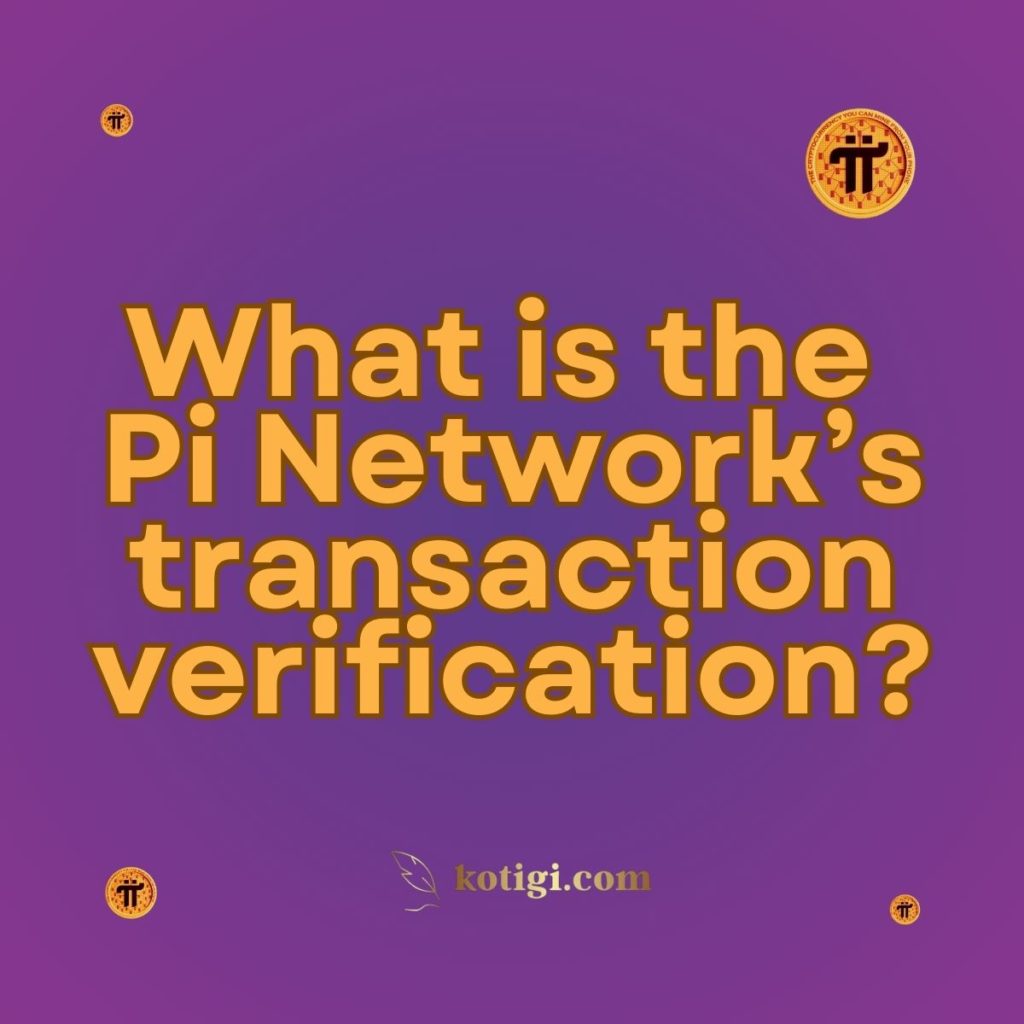
What is the Pi Network’s transaction verification?
The Pi Network’s transaction verification process ensures that all transactions within the ecosystem are validated and recorded accurately. Utilizing a combination of consensus mechanisms and user participation, this verification process enhances security, prevents fraud, and fosters trust among users, making every transaction reliable and transparent.
Introduction
Transaction verification is a cornerstone of any cryptocurrency network, playing a critical role in maintaining the integrity and security of the ecosystem. For the Pi Network, which aims to provide a user-friendly and accessible cryptocurrency experience, transaction verification processes are designed to ensure that every transaction is legitimate, secure, and transparent.
This blog post will delve into the mechanics of transaction verification within the Pi Network, its significance, the methods employed for verification, and how it contributes to the overall security and reliability of the network. Understanding these elements is essential for users who wish to engage actively with the Pi Network and utilize its cryptocurrency effectively.
Understanding Transaction Verification
Transaction verification refers to the process of validating transactions within a blockchain or cryptocurrency network. This process ensures that all transactions are legitimate, preventing fraudulent activities and ensuring the accuracy of the transaction records.
Key Components of Transaction Verification
The transaction verification process involves several key components:
- Transaction Submission: When a user initiates a transaction, it is submitted to the network for verification. This submission includes essential details such as the sender’s and recipient’s addresses, the amount being transferred, and any relevant metadata.
- Consensus Mechanism: The network employs a consensus mechanism to validate transactions. This mechanism ensures that all participants in the network agree on the validity of the transaction before it is recorded on the blockchain.
- Confirmation: Once a transaction is verified, it undergoes a confirmation process, wherein it is added to the blockchain. This confirmation solidifies the transaction, making it immutable and irreversible.
Importance of Transaction Verification
Transaction verification is crucial for several reasons:
- Security: Verification protects the network from fraudulent activities, ensuring that only legitimate transactions are processed. This enhances the overall security of the Pi Network.
- Trust: A reliable verification process fosters trust among users. When users know that their transactions are validated and secure, they are more likely to engage actively with the network.
- Data Integrity: By verifying transactions, the network maintains accurate and reliable transaction records. This integrity is essential for the proper functioning of the cryptocurrency ecosystem.
How the Pi Network Conducts Transaction Verification?
The Pi Network employs a unique approach to transaction verification, designed to balance security and user accessibility. Here’s how the verification process operates within the network:
User Participation
One of the defining features of the Pi Network is its focus on user participation in the verification process. Users play a vital role in validating transactions, making the network more decentralized and democratic.
- Consensus Mechanism: The Pi Network utilizes a consensus mechanism known as the Sociocratic Consensus. This approach relies on the collective participation of users to validate transactions, ensuring that no single entity controls the verification process.
- Node Participation: Users can run nodes, contributing their computational resources to the verification process. This decentralized structure enhances security and promotes user engagement.
Transaction Verification Steps
The transaction verification process in the Pi Network consists of several key steps:
- Initiation: A user initiates a transaction by submitting the necessary details through the Pi Network app.
- Broadcasting: The transaction is broadcast to other users in the network, allowing them to review and verify its legitimacy.
- Validation: Users participating in the network can validate the transaction based on consensus rules. This validation process ensures that the transaction adheres to the network’s regulations.
- Confirmation: Once a sufficient number of users validate the transaction, it is confirmed and added to the blockchain. This confirmation creates an immutable record of the transaction, securing it against tampering or fraud.
- Finalization: The transaction is finalized, and the relevant parties are notified of its successful completion.
Benefits of the Pi Network’s Transaction Verification
The transaction verification process within the Pi Network offers several benefits to its users and the overall ecosystem:
Enhanced Security
By involving users in the verification process, the Pi Network enhances security. The decentralized approach ensures that no single entity can manipulate transactions, protecting users from potential fraud.
Increased Trust
A transparent and reliable verification process fosters trust among users. When users can verify the legitimacy of transactions, they are more likely to engage with the network and utilize its cryptocurrency.
Accessibility
The Pi Network’s unique approach to transaction verification emphasizes accessibility. By allowing users to participate in the verification process, the network ensures that even those with limited technical knowledge can engage actively with the ecosystem.
Data Accuracy
The verification process maintains the integrity of transaction records, ensuring that all data is accurate and reliable. This accuracy is crucial for maintaining a seamless user experience within the network.
The Role of Transaction Verification in Decentralized Networks
In decentralized networks like the Pi Network, transaction verification plays a pivotal role in establishing trust and security among users. Here are some reasons why transaction verification is essential in such networks:
Trustlessness
Decentralized networks operate on the principle of trustlessness, meaning that users do not need to rely on central authorities to validate transactions. Transaction verification through user participation achieves this trustlessness, allowing users to independently confirm the legitimacy of transactions.
Conflict Resolution
In the event of disputes or discrepancies, transaction verification provides a reliable record that can be referenced to resolve conflicts. This transparency ensures fair outcomes and maintains community trust.
Responsible Engagement
The knowledge that their actions are subject to verification encourages users to engage responsibly within the network. This accountability contributes to a positive community culture and promotes ethical behavior.
Conclusion
Transaction verification is a critical component of the Pi Network, ensuring that all transactions are secure, legitimate, and accurately recorded. By leveraging user participation and a decentralized consensus mechanism, the Pi Network fosters trust and accountability among its users.
As the Pi Network continues to grow and evolve, the importance of effective transaction verification will only increase. By enhancing security, promoting user trust, and maintaining data integrity, the transaction verification process plays a vital role in the network’s long-term success.
Key Takeaways
- The Pi Network’s transaction verification process ensures that all transactions are validated and recorded accurately.
- Key components of transaction verification include transaction submission, consensus mechanisms, and confirmation.
- User participation enhances security and fosters trust within the network.
- The verification process consists of several steps, including initiation, broadcasting, validation, confirmation, and finalization.
- The benefits of the transaction verification process include enhanced security, increased trust, accessibility, and data accuracy.





